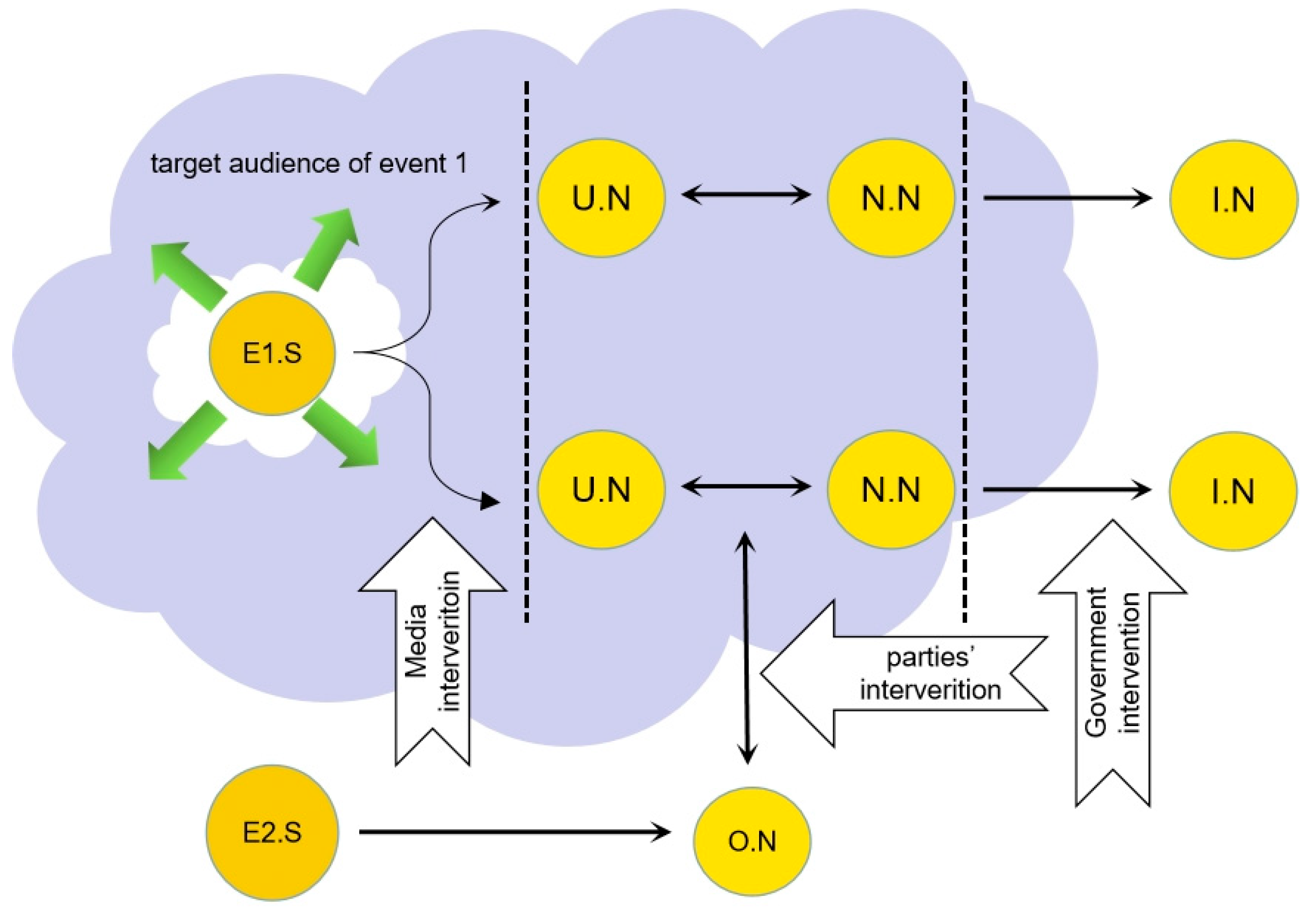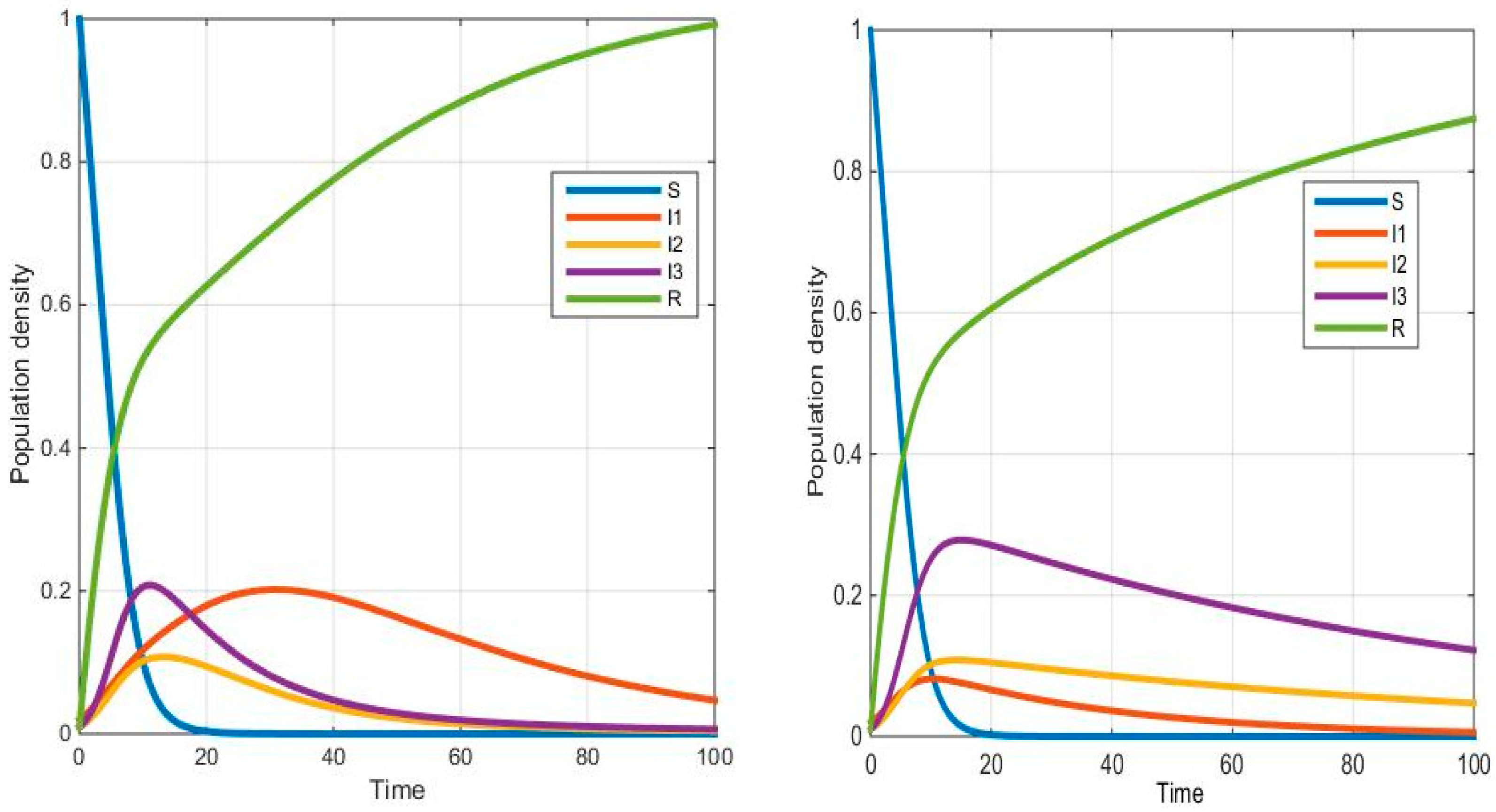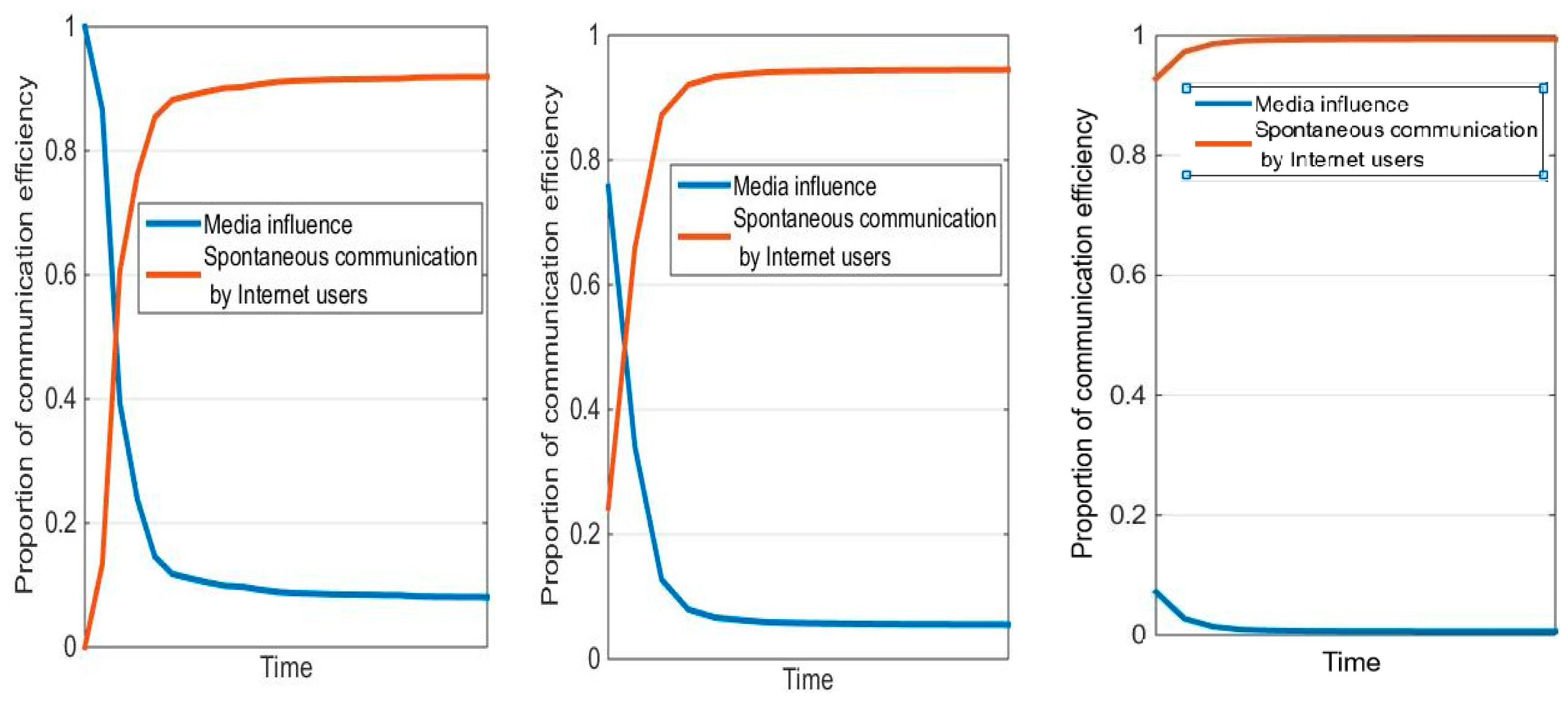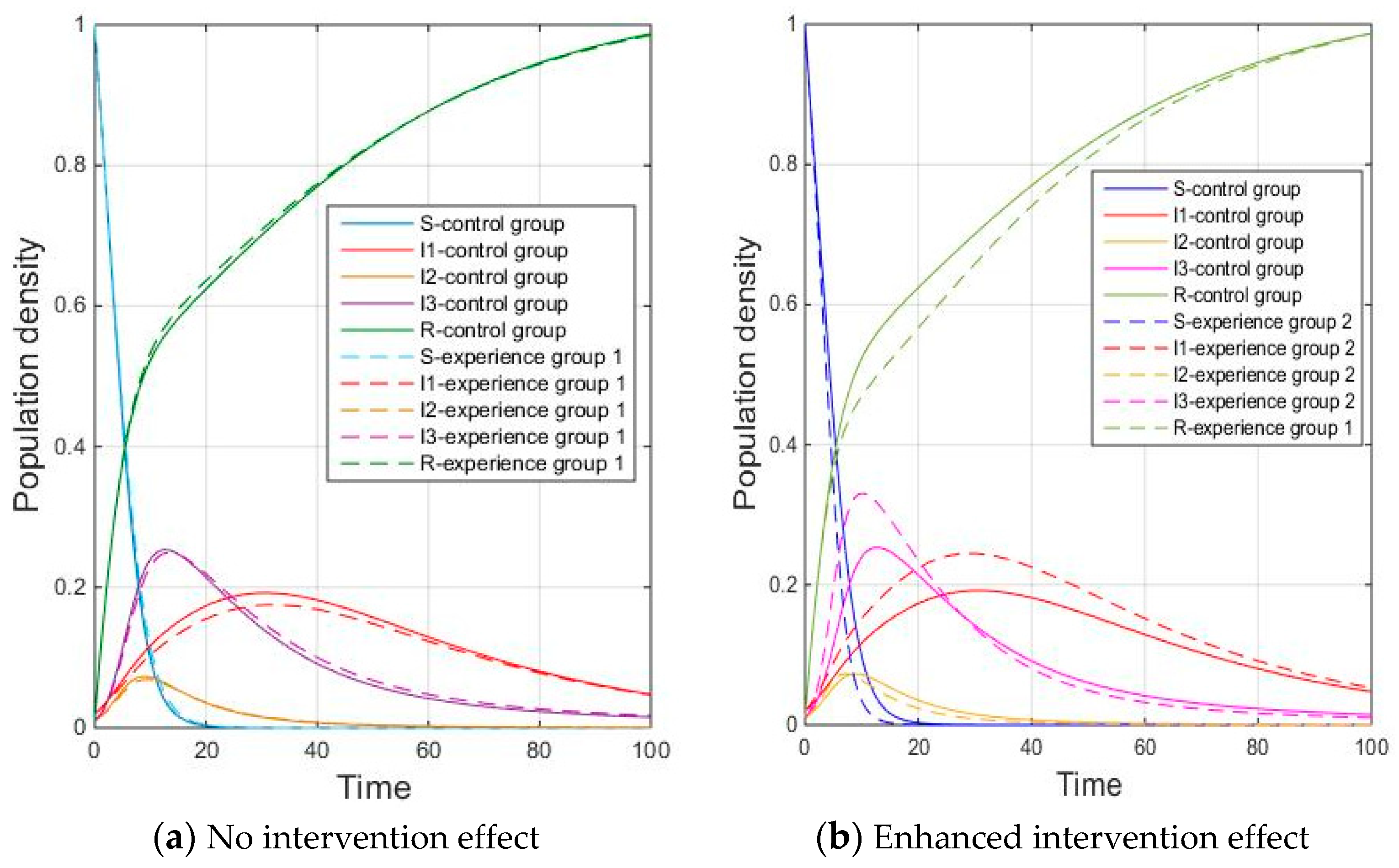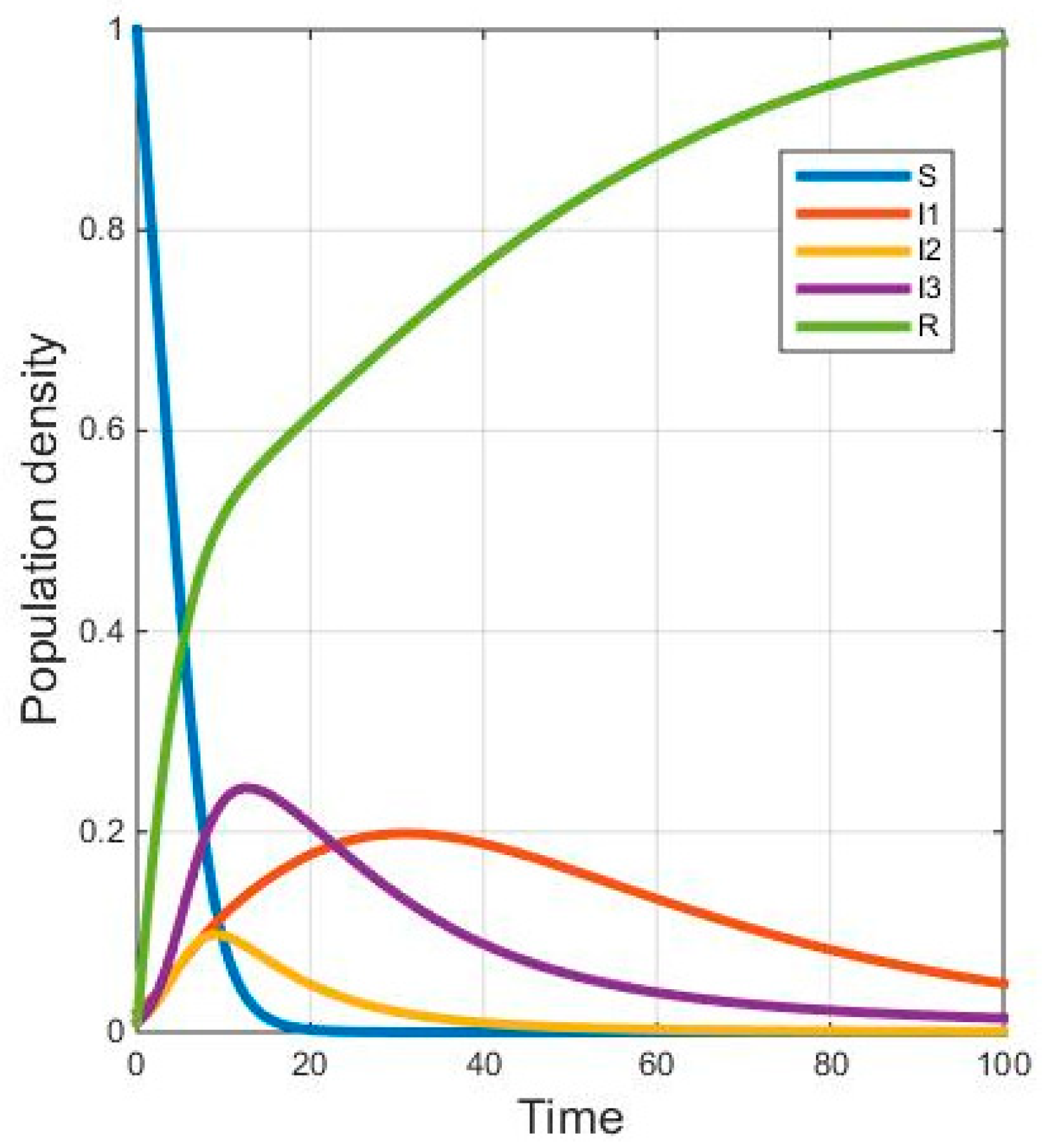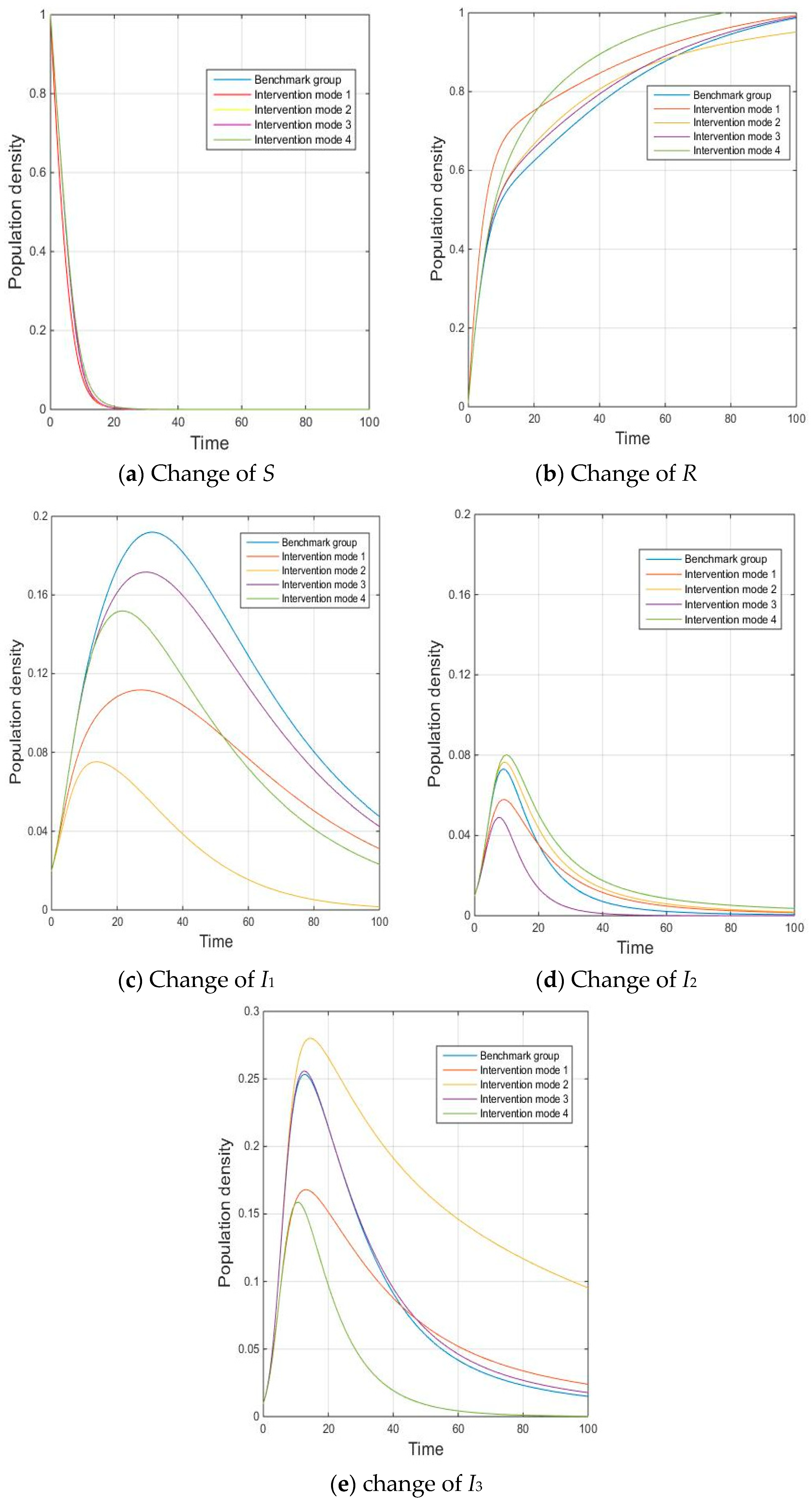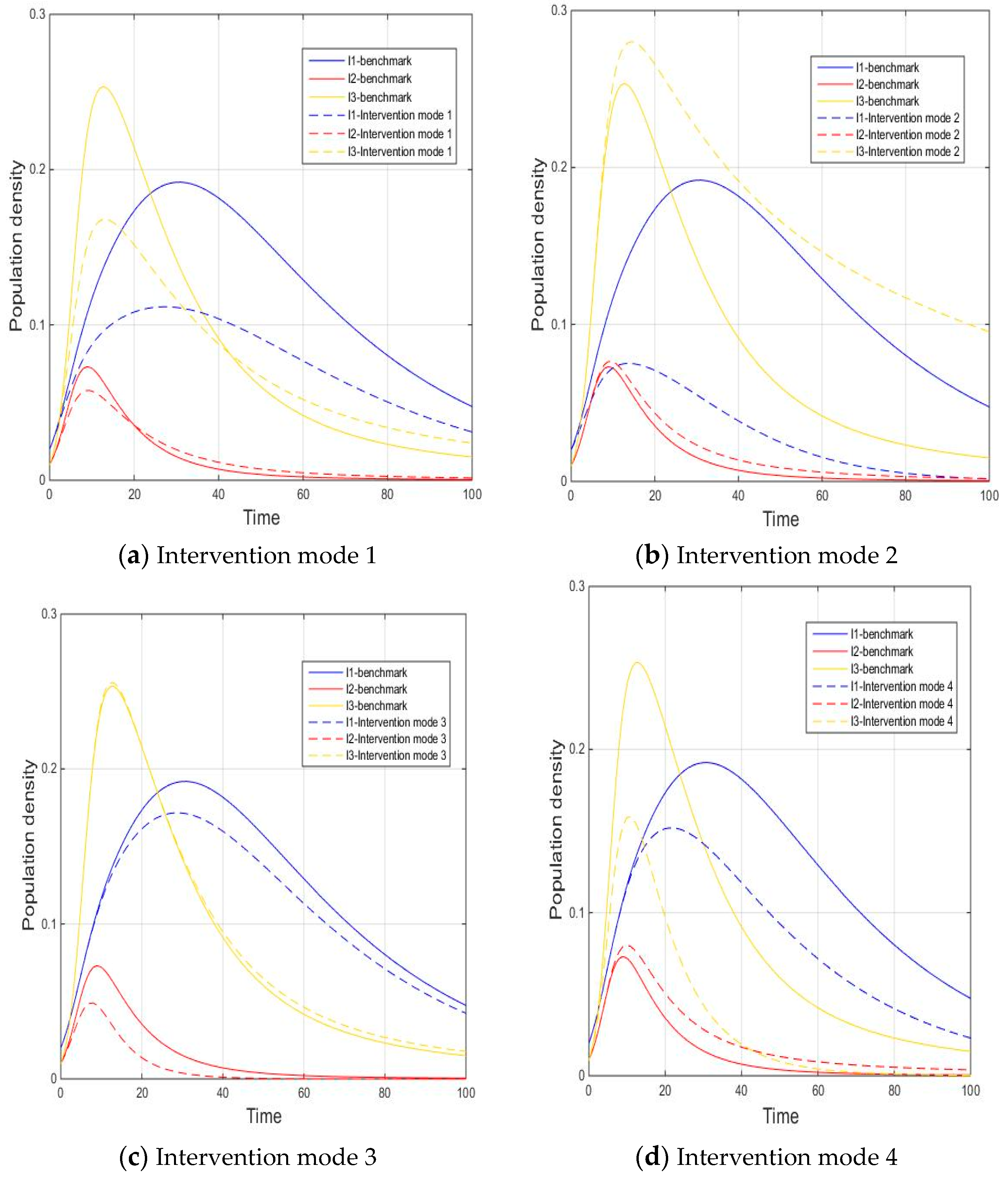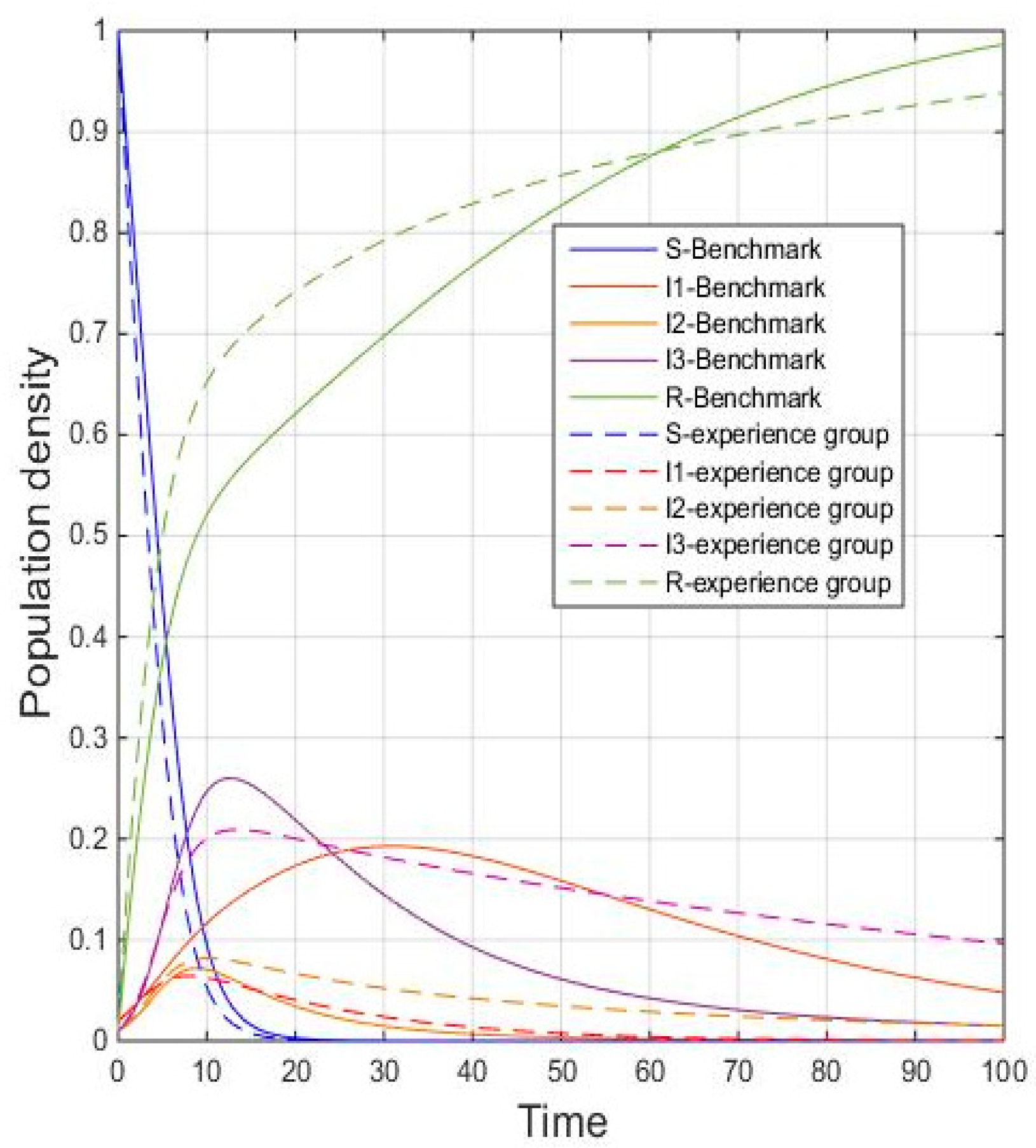1. Introduction
As WeChat, Facebook, Microblog and other social Internet application become more and more widely used, the communication effects of network public opinions are being strengthened by these new media applications [
1]. For example, the impact of negative public opinion related to COVID-19 caused the price of agricultural products to go up [
2] and the rumor that iodized salt could prevent radiation under the Fukushima nuclear problem caused the price of iodized salt to rise [
3]. To some extent, the influence of opinions and emotions in public opinion dissemination is more than the event itself [
4]. The spread of such negative public opinions further strengthens and deepens people’s fear and anxiety [
5], affects personal behavior decisions [
6], causes the formation and development of different values [
7] and makes people spontaneously search for relevant or similar information. If multiple public opinion events are interrelated, it will further expand the depth and breadth of the public opinion impacts, and even cause substantial fluctuations in the financial market or cause panic in social dimensions. Therefore, the dynamic mechanism about the spread and diffusion of negative public opinion is an important research topic which can predict the spread of public opinion, strengthen the effectiveness of control measures and minimize the damage caused by the spread of public opinion.
At present, the research on the dynamic mechanism of public opinion information dissemination in social networks mainly focuses on the process of information spreading. Because the information dissemination process in online social networks is very similar to the diffusion process of infectious diseases in the population, many scholars apply the communication dynamics model to social networks to solve the problem of information dissemination and control. In 1927, Kermack et al. [
8] proposed the SIR infectious disease model, which laid the foundation for the research of various infectious diseases. In 1964, Daley et al. [
9] proposed the DK model based on the idea of the infectious disease model, and studied the dissemination of information from the perspective of epidemiology. With the rapid development of mobile Internet technology, the infectious disease model has been gradually applied to the research of information dissemination of new media. Since then, most studies on network communication dynamics have been based on the classical SIR model. Later, scholars considered the complexity of modern network information transmission and proposed improved models such as SIS [
10], SIRS [
11,
12] and SEIR [
13].
With the intensive study of public opinion communication models in complex networks, many scholars have proposed new improvements and optimization in this direction [
14,
15,
16,
17,
18,
19,
20,
21,
22,
23]. Nekovee et al. [
14] proposed a model with a forgetting mechanism. Wang et al. [
15] proposed an improved SIR model based on a trust mechanism between unknown nodes and spreading nodes. Wan et al. [
16] considered the delay mechanism and refutation mechanism of rumor information, and proposed an improved SICS propagation model. Su et al. [
17] established the MB-SIR model from the perspective of incomplete reading behavior and different reading speeds of Weibo users. Considering the interaction between forgetting and memory mechanisms, Zhao et al. [
18] proposed a SHIR model to study the final propagation scale of rumors under various propagation rates, suffocation rates, forgetting rates and network averages. Liu et al. [
19] considered the differences of opinions and differences in the extensive participation and personalization of individuals in online social media and proposed the SHIR model to study the dynamics of competitive information diffusion. Rui et al. [
20] analyzed the information diffusion process from the perspective of susceptible nodes based on discrete time, and proposed the SPIR model. Zan et al. [
21] believed that there were groups with refuting opinions in rumor events. Based on this, they proposed a rumor propagation model which joined the counter offensive group. Wang et al. [
22] added the elements of users’ emotional expression to the process of public opinion information transmission, proposed an ESIS model to simulate the process of information diffusion and introduced a forwarding ratio between emotional users as the weight on the edge. Ebadizadeh et al. [
23] analyzed and considered the characteristics of rumor spread in real networks, and proposed an ISRC model with rumor control elements.
With the continuing deep research on public opinions, many studies investigate the effectiveness of public opinion intervention and regulation considering the tradeoff between governments and media. Zhang et al. [
24] introduced “intensification degree” and “divergence degree” to describe the media effect and established a communication model under media intervention. Wellie et al. [
25] believed that the transparency of government supervision and decision-making would affect the diffusion of online public opinion, and discussed the process of public opinion communication under government intervention. Wang et al. [
26] studied the control decision of public opinion event communication under government intervention, and gave the optimal strategy choice of government control. Tong et al. [
27] constructed and analyzed the multimedia network public opinion threat rating model based on the public opinion monitoring and prediction model. Wang et al. [
28] analyzed the elements and path of enterprise network public opinion heat generation from the dimensions of government and media, explored the generation mechanism of enterprise network public opinion heat and put forward different measures to reduce the negative public opinion heat.
When studying the evolution of public opinion communication in social networks, a certain public opinion communication process is likely to be affected by the communication of another related one, that is, there is widespread competition or interaction in the process of multiple public opinion information communication. The research on the interaction of public opinion events and the communication process is relatively new. In the latest research, the public opinion explosion effect caused by the aggregation due to some similarity between multiple events may lead to the correlation of multiple events in multiple spatial dimensions, causing a serious group crisis, which is defined by some scholars as “topic resonance” [
29,
30,
31,
32]. Dai [
30] introduced the theory of stochastic resonance and took issues, attitudes of government departments and other factors as variables to model and verify the influence of the resonance effect on the popularity of public opinion. Li et al. [
31] applied the stochastic resonance model to the research of public opinion resonance in colleges and universities, and the results showed that public opinion resonance occurred between public opinion events. Zhang et al. [
32] proposed a SEIR model for derivative topics, and solved the global equilibrium point and equilibrium solution. Song et al. [
33] considered the transformation of positive state and negative state, established an interaction model between them and analyzed the process of public opinion communication. Zan et al. [
34] constructed the DSIR model and discussed the propagation mode of rumors in complex networks. Zhang et al. [
35] analyzed the interactive propagation mechanism of multiple public opinion information in social networks based on the Lotka–Volterra model. Xian [
36] studied the impact of competitive public opinion information dissemination on different product supporting rates, and discussed the relationship between information dissemination intensity and product support rates.
In the above studies, there are few studies of how multi-agent interventions impact on the communication process of interactive public opinions. In addition, existing research on public opinion relations only considers the interaction of two public opinion information, but real cases often involve more than two public opinions interacting together to form much more complex conditions. In addition, most of the studies are theoretical models, and few of them are simulation studies combined with actual events. Thus, in this paper, a SI3R interactive public opinion communication model is proposed, considering the comprehensive multi-agent intervention of the government, the media and the parties involved. The stability of the model is verified theoretically. Further, real data of the case study are obtained and set as initial model simulation parameters, the multi-agent intervention and control measures are numerically simulated and effects of comprehensive public opinion control are obtained and put forward to suggestions for public opinion management.
The paper is organized as follows. In
Section 2, we establish the interactive public opinion propagation model of SI3R in the network environment of multi-agent interference, verify the stability of the model through mathematical methods and propose a method to calculate the model parameters using the data of sample cases. In
Section 3, we assign and debug the parameters of the model according to the sample case data and numerically simulate the effect of the interference of the government, the media and the parties involved in the model. Finally, in
Section 4, we summarize the research and prospects for the future.
2. Model Formulation
Different from the traditional single public opinion event research, the model constructed in this paper will consider the impact of interactive public opinion on user nodes in the homogeneous network, and add research under the heterogeneous network environment of interference of the media, government and parties involved. The specific differences are shown in
Figure 1.
In
Figure 1, node E1.S and E2.S represent information source of Events 1 and 2, respectively. U.N represents user node while N.N represents neighbor user node. O.N represents the user node infected by E2.S. I.N represents the inactive user nodes that lose interest in spreading public opinion.
Different from individual public opinion communication, user nodes in interactive public opinion communication will be affected by other user nodes in interactive events, and then change their own communication attributes. In the network environment composed of user nodes that can be reached, the status of user nodes in the spreading process changes according to the process of “be infected by the source of public opinion → spontaneous communication by users → become immune to information communication”. The impact of interactive events is mainly in the stage of the “spontaneous propagation process”, which is affected by the interference of the parties. Among the intervention impacts of other subjects, the media affects mainly in the stage “be infected by the source of public opinion”, and the government intervenes mainly in the stage “become immune to information communication”.
2.1. Spreading Model in Network Environment
It is assumed that there are three public opinion events that generate a topic interaction system, named as Event 1, Event 2 and Event 3. Firstly, we set the population involved in public opinion events as the sample range of the research. In the process of public opinion evolution, the status of Internet users can be divided into three types: S-state (completely unknown to the topic), I-state (believe and spread the topic) and R-state (lose interest in the topic). Under the condition of public opinion interaction, I-state can be divided into state I1 (believe and spread the topic), state I2 (believe and spread the current topic) and state I3 (believe and spread the current topic). The essence of the interactive communication mode is to attract the attention of network users so as to realize the behavior state transition of users when faced with different events. In this model, it is as follows: (1) S is transformed into I1, I2 and I3; (2) transformation from S is transformed into R; (3) mutual transformation among I1, I2 and I3; and (4) transformation of I1, I2 and I3 to R.
In the process of public opinion communication, Internet users are the main body of information communication, and their group distribution can reflect the evolution of public opinion. González’s research shows that the group density index can fully reflect the group distribution in the process of public opinion transmission [
37]. In this paper, the group density is used to characterize the state of each netizen group.
The corresponding communication rules are as follows: after being contacted by the media or other communicators, the unknown S is transformed into the infected I with a certain probability, or it may directly lose interest in topic communication and become the immune R. Due to the forgetting mechanism, the infected I may be transformed into the immune R with a certain probability, or may be attracted by other events and become the disseminator of other events that are more specific, more attractive and have higher communication status. Thus, we use αi (i = 1, 2, 3), βi (i = 1, 2, 3), λi (i = 1, 2, 3) and σ to represent the conversion probability between populations.
Meanwhile, In the process of public opinion communication, the media, government and public opinion parties can all have a special intervention effect on public opinion communication. Formed by various interventions, this network environment is a heterogeneous network environment different from the normal homogeneous network. In this paper, the intervention effect of media U, government G and those directly involved C on public opinion is expressed by the conversion rate among different groups. Among them, the media intervention effect M is mainly reflected in the transformation from S to I1, I2 and I3; the government intervention effect O is mainly reflected in the transformation from S to R and from I1, I2 and I3 to R; and the intervention effect L of the parties involved is mainly reflected in the mutual transformation between I1, I2 and I3.
Figure 2 shows the interactive public opinion propagation model in the network environment, and the meanings of symbols are shown in
Table 1.
For the population conversion rate under media intervention,
is the initial value of conversion without intervention:
For the population conversion rate under government intervention,
is the initial value of conversion without intervention:
For the population conversion rate under the intervention of the parties,
is the initial value of conversion without intervention:
Li is set to indicate the influence of the parties on the events. When Event 1 has a higher communication status than Event 2, λ1 is a positive number; otherwise, it is negative. When Event 1 has a higher communication status than Event 3, λ2 is a positive number; otherwise, it is negative. When Event 2 has a higher communication status than Event 3, λ3 is a positive number; otherwise, it is negative.
2.2. Equilibrium Point and the Propagation Threshold
The stability of the transmission system is discussed by the equation in the transmission stage from the transmitter
S to the infected
I. Through the construction of the Lyapunov function, the global asymptotical stability of the disease-free equilibrium point and the endemic equilibrium point are given.
Then, eight equilibrium points are calculated and obtained:
Among these equilibrium points, P6 is the disease-free equilibrium point; other solutions are the endemic equilibrium point.
In the equilibrium state, P2, P3 and P4 belong to three symmetrical points, which represent only one discussion sound in the actual propagation. Supposing the event intensity of 3 is I1 > I2 > I3, then solutions P3, P4 and P8 are inconsistent with the conditions, so the solutions P3, P4 and P8 are omitted. Solution P1, < 0, is rounded off. Similarly, we round off P7. The solution P5 indicates that multiple event parties exist simultaneously and reach an equilibrium state in the process of network propagation. It is difficult for it to exist in actual events, and I1 > I2 > I3 cannot be maintained. Thus, it is omitted. Because of its symmetry, the conclusion is still valid when the order of the intensity changes. To sum up, in this paper, we only consider disease-free equilibrium point P6 and endemic equilibrium point P2.
There is a propagation threshold R0 in the network public opinion propagation dynamic system which is used to measure the propagation efficiency of public opinion on the platform. Public opinion propagation will gradually disappear when R0 ≤ 1. When R0 > 1, public opinion propagation will continue to occur.
Setting
x = (
I1,
I2,
I3,
S)
T, Equation (6) can be expressed as
dx = F(
x) −
V(
x), where
Setting H = FV−1, the spectral radius can be obtained, so .
2.3. Stability Analysis
(1) Stability analysis of disease-free equilibrium.
When R0 ≤ 1 and F(x) − V(x) ≤ 0, in this case, only the values of I1, I2 and I3 are 0.That is, there are no communicators in the public opinion system, but only disease-free equilibrium points . The stability of P6 can be proved according to Lyapunov’s second method, constructing the Lyapunov function.
When
≤ 1,
According to the LaSalle invariant set principle, the disease-free equilibrium point P6 is globally asymptotically stable.
(2) Stability analysis of the endemic equilibrium point.
When R0 > 1, public opinion propagation will continue to occur, so I1, I2, I3 > 0 and the condition is inconsistent with P6, so there is only one endemic equilibrium P2 in the model. The stability of P2 is verified below.
For the construction matrix
, carrying in the condition
, the matrix becomes
Then, the characteristic equation of the matrix can be found:
The characteristic equation is calculated and four characteristic roots are obtained:
Supposing the event intensity of 3 is
I1 > I2 > I3, the condition
is set, and
R0 > 1; thus, all four roots are less than 0. The parameters of the characteristic equation are
Then, a judgment calculation can be made:
One can see easily Equation (13) of the calculation result is valid. According to the Routh Hurwitz stability criterion, the model is locally asymptotically stable at the equilibrium point P2.
2.4. Assignment Method
After verifying the stability of the model, to assign model parameters from the numerical value of case events, we improve the single public opinion event assignment method proposed by Chen et al. [
38] and apply it to the simulation of interactive public opinion events. In the network environment of multi-agent intervention, Event 1 is set as an example, assuming that Events 2 and 3 have no impact on it. The number of infected network user nodes is
I1(
t), and the recovery rate of infected network user node is
β1, so the number of immunized is
β1 × I1(
t). The number of potential network user nodes to be infected is [
N1 − I1(
t) −
β1 × I1(
t)], where
N1 is the saturation number of network user nodes in Event 1.
In this paper, the media is regarded as the external driving force, and its effect on potential network user nodes is defined as M1, so the effect of media on potential network user nodes is M1 × [N1 − I1(t) − β1 × I1(t)]. The probability of transition from S to I1 is α1. Assuming that there is no significant difference in the social influence of each node, the proportion of the infected network user nodes in the total number of user nodes involved in Event 1 is I1(t)/N1, that is, their influence in the public opinion social system can be simplified as I1(t)/N1. In addition, the effect of internal conversion is α1 − M1 and the number of potential network user nodes affected by it is [N1 − I1(t) − β1 × I1(t)], so the spontaneous spreading effect within potential network user nodes and infected network user nodes is (α1 − M1) × I1(t)/N1 × [N − I1(t) − β1 × I1(t)].
If the propagation impact of Event 2 and Event 3 on Event 1 is considered, it is shown as λ1I1I2 and λ2I1I3 in the model. Assuming that the communication effect is reflected by the user nodes who repeatedly participate in the multi-event public opinion communication, this kind of influence will reach its peak in a very short time after the occurrence of interactive events, so the effect can be calculated by the number of user nodes who repeatedly participate in the multi-event public opinion communication. Taking the impact of Event 2 on Event 1 as an example, supposing that the number of user nodes participating in the two events is N1,2, proportion accounting for N1,2/N1, and supposing the impact coefficient of repeated transmission is f, the additional spreading effect is (f − 1)(α1 − M1) × N1,2/N1 × I1(t)/N1 × [N1 − I(t) − β1 × I1(t)]. In the model, the λ value can be confirmed by λ1 = (f − 1) × N1,2/√(N1 × N2).
To sum up, adding various influence effects,
I(
t) can be used to express daily new infected user nodes
n(
t). The general function of three events is obtained as follows:
3. Case Study and Results
3.1. Assignment Calculation
From 29 December 2020 to 10 January 2021, China Pinduoduo company had three consecutive negative public opinion events, including “sudden death of Pinduoduo employees”, “suicides of Pinduoduo employees” and “dismissal of Pinduoduo employees after publishing photos of ambulance entering the company”. These public opinions are negative events of corporate social responsibility. The government, the media and the parties all participated in the evolution and the game of public opinion, which are typical interactive public opinion events under multi-agent intervention. These three public opinion events are related together to some extent, so we identified them as Event 1, Event 2 and Event 3. Then, we designed a Python program to collect 10,348, 5210 and 8532 pieces of data, respectively. According to the amount of public opinion data, the propagation status of multiple events is
I1 > I3 > I2. Taking Event 1 as an example, the daily increase
n (
t) and cumulative spread
I(
t) of the relevant Microblogs on the Microblog platform are shown in
Table 2.
Fitting the collected
I(
t) and
n(
t) data with the univariate quadratic function, the daily spread function of network public opinion can be obtained:
The correlation coefficient of Equation (14) is brought into Equation (15) to solve the parameter equation:
Counting the number of people repeatedly participating in different events, N1,2 = 2727, N1,3 = 2550 and N2,3 = 1428 are obtained.
The impact coefficient of repeated transmission f is set as 1.7. According to the formula λ1 = (f − 1) × N1,2 /√(N1 × N2), λ1 = 0.26, λ2 = 0.19 and λ3 = 0.15 are obtained. Meanwhile the public opinion status of each event is that I1 > I3 > I2. So, confirming λ1 and λ2 are positive, λ3 is a negative value. According to Formula (14), α1 = 0.363, β1 = 0.032 and M1 = 0.029.
Solving the relevant parameters of Event 2 and Event 3 in the same way, the corresponding fitting function is
By substituting it into Equation (15), we can obtain α2 = 0.635, β2 = 0.007, M2 = 0.022, α3 = 0.861, β3 = 0.004 and M3 = 0.043. However, since the parameters are obtained by fitting the collected data first and then solving them, it can be expected that there will be a certain gap between the obtained parameters and the actual ones. Therefore, it is necessary to continuously adjust the calculated parameters to make the simulation results reflect the actual process. Since the occurrence interval of the three events is short, they are regarded as occurring at the same time to obtain a relatively uniform time variable.
Because
, one can obtain
. According to the statistical results of the collected data, the official government accounts questioned the enterprises concerned in Event 1, but the government did not respond directly to Events 2 and 3. Therefore, the conversion rate
in the homogenous environment without government intervention is set as the minimum value of 0.01, and the government intervention
O1 = 0.02 and
O2 = O3 = 0. After removing the contribution from the duplicate participants of the parties involved, calculating that
= 0.24,
= 0.16 and
= 0.12, the intervention effects of the parties involved are
L1 = 0.02,
L2 = 0.03 and
L3 = 0.03. The direct conversion σ is 0.1, taking
O4 =
O1 = 0.02, so
is 0.08 in the model; to sum up, the parameter settings for multi-agent impact contribution simulation after debugging are listed in
Table 3.
3.2. Simulation Experiment
When the input rate of Internet users A is 0.00001, we discuss the trend of interactive public opinion propagation and diffusion in the network environment; related parameter settings are given by
Table 4. Meanwhile, the simulation results when the three events are independent of each other are established as the control group to study whether the model design of public opinion interactive diffusion conforms to the reality (
Table 4). The results of simulation are shown in
Figure 3.
In the heterogeneous network environment with public opinion interaction, as time goes on, potential contacts will preferentially accept the infection of Event 1 under the joint action of the three events, that is, Event 1 will absorb the information resources of the other two events and occupy a dominant position in public opinion.When under the assumption that there is no interaction of public opinion, Event 1 cannot absorb the information resources of the other two events and subside quickly.It is not accord with the actual situation.Therefore, the simulation of public opinion interaction is more realistic.
3.3. Regulatation and Control by the Media
Among three interference subjects, the intervention influence of the media is from
S state to
I state. According to the above assignment calculation results, the guiding function parameters
M of the media in the three events are 0.03, 0.03 and 0.05. The state transition from state
S to state
I is mainly influenced by the spreading effect of media influence and the spreading effect of spontaneous communication by Internet users. According to the previous research, the spreading effect of media influence can be expressed as
M1 × [
N1 − I1(
t)
− β1 × I1(
t)]. The spreading effect of spontaneous communication by Internet users can be expressed as (
α1 − M1)
× I1(
t)
/N1 × [
N1 − I1(
t)
− β1 × I1(
t)]. Bringing the daily collected data into the formula calculation to build the contribution proportion, the contrast between the spreading effect of media influence on the Internet users and the spreading effect of spontaneous communication among Internet users is shown in
Figure 4.
According to the comparison of communication efficiency in
Figure 4, it can be seen that over time, the contribution of spontaneous communication among Internet users in the
S → I process increased, while the contribution of media influence to communication efficiency decreased. The driving force of media on public opinion communication has a reverse relationship with the spontaneous communication effect of the spread Internet users. This shows that with the passage of time, the number of Internet users being infected increased, and the leader of public opinion communication gradually shifted from the media to the group of Internet users, which is in line with the objective law of public opinion communication. In the early stage of public opinion, the media came into contact with public opinion events earlier, and the communication efficiency of media is higher than that of spontaneous communication by Internet users. Thus, the media could occupy a dominant position in the process of public opinion communication at this stage. However, with the promotion of the communication process, the group of infected people who have not been cured expanded, becoming the active promoter of public opinion crisis, and finally causing the high proportion of communication efficiency.
Compared with Events 1 and 2, Event 3 was affected by the first-mover event when it occurred. There were a large number of Internet users interested in the elements of the event that joined the communication at the initial time of the event, which greatly improved the spontaneous communication contribution of Internet users at the initial stage of public opinion. Therefore, the communication process at the beginning was dominated by Internet users.
In order to explore the strengthening and guiding effect of the media on relevant public opinion, this paper sets the actual model as the control group, and sets up two experimental groups for simulation analysis. In the parameter design of experimental group 1, we removed the intervention of the media, that is, the evolution process of public opinion is completely dominated by the spontaneous communication of Internet users. In experimental group 2, we assume that the media side strengthens the relevant resource investment, making the media impact parameter
M of each event increase by 0.09, so as to study the evolution process of public opinion under the enhanced media intervention.Detailed parameter settings are shown in
Table 5.
The public opinion evolutions with no media intervention and with enhanced media intervention are shown. The dotted line part is the experimental group, and the solid line part is the simulation control group of the real situation. According to the previous research, the role of media intervention mainly dominates in the initial stage of public opinion, so our research on the role of media intervention mainly focuses on the curve from the occurrence of the event to the peak of the event.
It can be seen from
Figure 5 that the reinforcement effect is positively correlated with the propagation time of the topic, the number of infected people and the propagation peak. In
Figure 5a, if there is no media intervention and the curve of I
1 in the experimental group is below the curve of the control group, the propagation peak of Event 1 decreases, the time required reaching the peak increases and the number of infected persons at the same time decreases considerably. At the same time, the
R curve of the experimental group is slightly higher than that of the control group, indicating that the rehabilitation efficiency of the infected people was improved after removing the publicity effect of the media on public opinion. In
Figure 5b, according to the curves under different
I1, I2 and
I3, with the enhancement of the media intervention, the peak of public opinion increase correspondingly, and the time required for public opinion to reach the peak is also shortened. Meanwhile, the number of infected people increases relatively, and the curve R of the experimental group l drops significantly. Obviously, under the intervention of the media, the probability of losing interest in events and turning into immune people during the outbreak of communication decreases. In addition, in the process of the event from outbreak to recession, the curve of the experimental group converges to that of the control group, which also proves that with the development of the event, the impact of the media on public opinion decreases, and the Internet users gradually become the dominant public opinion.
In
Figure 5b, it is assumed that the intervention role of the media is strengthened. Although the time for the infected people to reach the peak is shortened and the peak height is increased, when the same media resources are invested in each event, the public opinion communication of different communication statuses will have different effects. The growth rate of Event 2 with weak communication status is completely lower than that of Events 1 and 3, and its infected users are often infected and transformed by other events. This phenomenon is particularly obvious in the public opinion recession period. On the premise of enhancing the media communication efficiency, the impact of Events 2 and 3 is reduced in the recession period, and a large number of infected people are transformed into the communicators of strong Event 1. Therefore, the government should not only focus on a single topic of public opinion, but also comprehensively consider multiple public opinions and their interaction when conducting public opinion counseling and appeasement with the help of the media.
This has also led to corresponding thinking. Since Event 1 has the largest social response and the worst controllability, under the condition of other factors being unchanged, can we ease the public opinion related to Event 1 by increasing the media’s resource investment in other events to change the public opinion evolution? By continuously adjusting the correlation coefficient simulation, if other conditions remain the same, increasing the media resource investment in Event 2 to make media intervention effect
M2 = 0.1, so
α2 is 0.58, the infection trend of Event 1 and Event 2 converges at the initial stage of public opinion development. The simulation results are shown in
Figure 6.
When the media intervention is strengthened to 0.1, at the initial stage of public opinion, the curve of I2 converges with that of I1. Therefore, when M2 is higher than 0.1, the public opinion status of Event 2 can be reversed beyond that of Event 1. That is, if the government increases the media’s resource investment in Event 2 from 0.03 to 0.1, the initial public opinion trend will reverse. However, with the passage of time, the overall public opinion situation will still gradually turn to the control of Event 1. Although this behavior cannot completely change the public opinion situation, this method can delay the rapid expansion of public opinion influence during the outbreak of public opinion, maintain the relative stability of public opinion evolution, buy time for public opinion managers to ease the situation and calm the public opinion crisis.
3.4. Regulation and Control by the Government
According to the previous research conclusion, the infected Internet users are the main promoters of the development of public opinion. Thus, we can provide suggestions for the government to take relevant actions after the outbreak of public opinion events: on the one hand, after the event is exposed and spread, the communication efficiency of the government’s response and feedback is far less than that of the internal diffusion of Internet users, and the government’s response period usually does not belong to the outbreak of public opinion, so there is no need to worry that its own influence will contribute to pushing the public opinion heat to the peak; on the other hand, government intervention can resolve the crisis faster and reduce the harm caused by public opinion. We can study the best way to deal with it by exploring its impact on different events in the evolution of public opinion.
This paper sets the simulated public opinion state as the benchmark, and increases the government intervention to various groups on its basis. There are four ways of government intervention, namely, to improve the direct immunization rate, that is, to strengthen the direct transformation of user nodes from
S to
R through government publicity, and to increase the transformation efficiency of
I to
R in the three events by making a commitment, giving investigation results and guiding public opinion pressure. We set the added value as 0.05 to construct the parameter conditions of the simulation experiment, and obtain the changes of each group under different intervention methods.Detailed parameter settings are shown in
Table 6 and the results of simulation are shown in
Figure 7.
According to
Figure 7a,b, compared with the reference state without subject intervention, the four intervention modes have little impact on the number of
S, but it has a great influence on the change of
R. Among them, intervention modes 1 and 4 can greatly improve the transformation rate of healers, while intervention modes 2 and 3 have no obvious effect, and intervention mode 2 even slows down the cure rate. This result shows that in the early stage of public opinion communication, when the related public opinions occur, the government should focus on dealing with the events that occur at close intervals and have high real-time public opinion hot spots, so as to reduce the possible public opinion heat transmission in the future and refuse to allow the recurrence of more difficult public opinion problems. Meanwhile, when the corresponding conditions are met, focus should be on intervention mode 1, that is, the direct immunization rate should be increased and the direct transformation from
S to
R immunized should be promoted by issuing the investigation signal or publishing the official investigation results.
The four intervention methods can change the number of I in the three events, and
I1,
I2 and
I3 will gradually rise to a certain peak and then gradually decline. As shown in
Figure 7c, compared with the benchmark group, the four intervention methods can not only reduce the peak value of
I1, but can also shorten the time for
I1 to reach the peak value. Among them, the direct intervention method 2 for Event 1 is the best. In
Figure 7d, only interference mode 3 can have a good effect on reducing the public opinion heat of Event 2. In
Figure 7e, interference modes 1 and 4 can have a good effect on reducing the public opinion heat of Event 3. The reason for this difference is the discrepancy of public opinion status in the interactive public opinion system. Event 1 has the highest public opinion status and can improve its popularity by transforming the infected in interactive Events 2 and 3. Therefore, the government control and intervention only for Events 2 and 3 will also have an effect on Event 1. On the contrary, the intervention only aimed at Event 1 will relatively reduce the public opinion status of Event 1, weaken its transformation effect on the infected persons in Events 2 and 3 and lead to the increase of public opinion heat in Events 2 and 3.
In order to better analyze the impact of different intervention methods on interactive public opinion, we drew a group diagram of the impact of different intervention methods on the number of I in different events.
As shown in
Figure 8, the four intervention modes are under different
I1, I2 and
I3 numbers. Under the condition of intervention mode 2, the quantity peak of
I2 increased, and
I1 and
I3 decreased; under the condition of intervention mode 3, the quantity peak of
I3 increased, and
I1 and
I2 decreased; and under the condition of intervention mode 4, the quantity peak of
I2 increased, and
I1 and
I3 decreased. It can be seen that when the government intervenes, it will not only reduce the heat of an event, but also increase the discussion heat of other topics. Therefore, when making intervention decisions, the government should comprehensively consider the impact of multiple interactive public opinions and their interactive relationships, so as to achieve better intervention effects.
Therefore, in the case event, the social impact of Event 1 is large, and its potential public opinion crisis is high. The government should focus on intervention mode 2 during the outbreak of public opinion. It can increase the removal rate of Event 1 by advancing the time of government intervention, increasing the number of official accounts participating in the event and increasing the frequency of official accounts, so as to promote the transformation of the infected of Event 1 into immune people. With the occurrence of Events 2 and 3, the popularity of related public opinion has shifted. The government should make a timely adjustment to the intervention mode, strengthen the guidance of Events 2 and 3 and strive for the right to speak public opinion, so as to increase the removal rate of the infected in related events and make the infected change to immune status.
3.5. Regulation and Control by the Parties Involved
After the public opinion event, Pinduoduo officials released inappropriate remarks on the Zhihu China platform, ignored the comfort of employees and caused employees to post attacks on the Momo China platform, which caused a series of negative events, such as the suicide of new employees and the dismissal of the employee who published photos of ambulance emergency workers. These behaviors undoubtedly aggravated the public opinion crisis. If the parties concerned can pay attention to appeasing the employees and relevant personnel after the occurrence of negative events and conduct appropriate public relations work, it will have a positive effect. If the parties provide comfort to employees through appropriate public relations is regarded as a good constraint, the relevance between events will be reduced. In this paper, a good constraint condition is set to make the constraint coefficient
λ reduced by 0.1; we conduct simulation experiments under this condition to explore the changes of each group. The relevant parameters are shown in
Table 7 and the results of simulation are shown in
Figure 9.
Compared with the benchmark state, different constraints largely affect the relevance of events by changing the propagation status of events in the evolution of public opinion. Under the three constraints, the peak value of public opinion and the time required to reach the peak value of Event 1, which has the highest public opinion status, decreased correspondingly, especially in experimental groups 2 and 3. According to
Figure 9b,c, after the corresponding constraints are realized, the public opinion peak of Event 1 decreases, and the time required to reach the peak is shortened. The event that occupies the dominant position in the evolution of public opinion has also become Event 3. However, from the perspective of whole public opinion, the public opinion peak of Event 2 and Event 3 has increased, and the public opinion heat curve has also increased, indicating that the environment of the multi-event public opinion system has deteriorated. The relative public opinion environment of Event 1 with the highest threat improved. Therefore, such interference can have a significant impact on the public opinion heat of specific events, and can be applied to events with potential crisis or significant social repercussions to avoid serious consequences caused by absorbing the heat of related events.
3.6. The Ideal Effect of Multi-Agent Intervention
The intensified intervention of the media, the government and the parties concerned will have a significant impact on the public opinion system. This paper assumes to strengthen the intervention of each subject at the same time to conduct simulation, in order to explore the ideal results of public opinion governance.Detailed parameter settings are shown in
Table 8.
According to the results of simulation in
Figure 10, under the condition of multi-agent enhanced interference, the peak values of
I1 and
I3 are relatively reduced, the peak values of
I2 are slightly increased and the time required for each event to reach the peak is reduced. That is, the outbreak period of public opinion is shortened. For Event 1 with potential crisis, the peak value of public opinion decreased to 1/3 of the actual value and the outbreak period decreased to 1/3 of the actual value. The communication efficiency decreased, indicating that the public opinion has been appeased and calmed down, and the possibility of public opinion crisis has been greatly reduced. It can be seen that the comprehensive use of multi-agent intervention ability to calm public opinion and reduce the damage is effective.
4. Conclusions and Suggestions
In this paper, a multi-agent intervention communication model of public opinion interaction among three events was formulated, and detailed numerical simulations were performed based on data of an actual case study. The originality and contribution of this paper lies in: building a model of multi-agent interference and multi-public opinion interaction, putting forward a feasible method of assigning model parameters to actual case data and conducting simulation experiments on sample cases to obtain the best comprehensive interference effect. In the process of interactive public opinion, the same intervention method has different effects on public opinion events with different public opinion status. A single intervention measure to reduce the heat of a public opinion event may lead to an increase in the attention of other public opinion events. Therefore, the whole public opinion evolution system should be considered when making intervention decisions. Compared with single subject intervention, multi-agent intervention can better control the evolution of complex public opinion and effectively assist public opinion managers to quell public opinion crisis. Combined with model analysis and simulation experiments, public opinion administrators should adopt compromise coping strategies to quell the public opinion crisis and reduce the harm caused by the wave of public opinion. The following conclusions can be drawn:
(1) After the public opinion event is exposed, the public opinion manager should assess its risk level to decide whether to appease public opinion with the help of the media at the initial stage, or increase the media’s resource investment in other related events to compete for the dominant position of the public opinion system, so as to curb the rapid growth of the infected people.
(2) When interactive public opinions occur and correlate, the public opinion manager should focus on dealing with events with high real-time hot spots at close intervals, reducing the public opinion heat transmission that may be caused in the future, and avoiding the recurrence of more difficult public opinion problems caused by the heat transmission. The government can issue rectification opinions and measures through the official speech field. The media should also increase the resource investment of official speech. The parties concerned should make positive responses to increase the direct immunization rate and promote the direct transformation from S to R.
(3) All the parties concerned should improve their own constraints by appeasing their internal emotions, and responding to relevant public opinion through appropriate public relations measures, so as to reduce the possibility of other negative events or reduce the correlation between events, and avoid the heat transfer to events with high threat.
Further, there are still some deficiencies to be overcome for future research. First, the method to determine the model parameters is through function fitting, which will produce a certain error; the assignment process in the subsequent research can be improved as well. Secondly, real public opinion events involve infected netizens and uninfected netizens. However, the netizens infected by public opinion also have differences, forming an opposition of opinions. The impact of related events on the opposite sides is different, and further research on the degree of divergence can be added. Finally, the evolution of public opinion events usually goes through multiple stages of occurrence, development, evolution and recovery. The current model can be improved according to the nature of each stage to study the interactive propagation law of a variety of public opinion information in each stage and solve the problem about the difference of intervention timing between different stages in the future.
